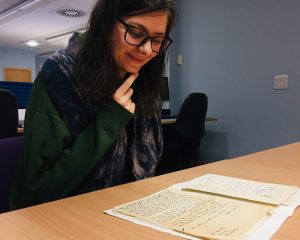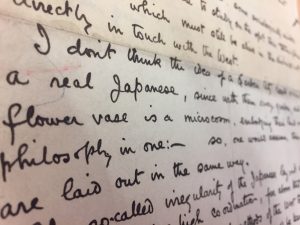Journey with us to 1908 as Patrick Geddes and Frank Mears’ look to Japan and the East for urban planning inspiration. Archives volunteer and MSc Library and Information Studies student, Tara Copic, shares with us her collection highlights from the Patrick Geddes Archives.

Archives cataloguing volunteer, Tara Copic, reading one of her favourite discoveries from the Patrick Geddes correspondence: A letter from Frank C. Mears to Patrick Geddes, 22 Jan 1908, which discusses the Japanese Garden. (Ref: T-GED9/818).
Since October 2019 I have been volunteering with the Universities of Edinburgh and Strathclyde’s collaborative archives cataloguing project ‘Evergreen: Patrick Geddes and the Environment in Equilibrium’. I am an MSc Library and Information Studies student at the University of Strathclyde and I volunteer with the project for a few hours once a week at the University of Strathclyde Archives and Special Collections. When I started volunteering, I received training on how to use professional archive description standards and cataloguing software AToM.
After 5 months of volunteering with the project, I am now familiar with and have practical experience in working with professional archive catalogue standards and systems. I have enjoyed working with a series of correspondence, identifying correspondents, correcting inaccuracies and adding content. In total, I have helped to enhance over 120 catalogue descriptions, making the collection more accessible and easy to navigate.
Working through this series of correspondence (currently I’m in 1908!), has given me a fascinating insight into the rich life and work of Patrick Geddes. I am getting to know better his wide network of friends, colleagues and associates, that range from teachers and academics, to scientists and more. One of my favourite discoveries is a letter from Geddes’ son-in-law, the architect and town planner, Sir Frank Charles Mears (1880-1953) to Patrick Geddes at the Outlook Tower. In the letter, Mears discusses the beauty of the Japanese garden in relation to Japanese Town Planning Practice:

Extract from a letter from architect and son-in-law, Frank C. Mears (1880-1953) to Patrick Geddes (1854-1932) discussing the Japanese garden.
“I don’t think the idea of a Garden City could occur to a real Japanese, since with them every garden, and even flower vase is a microcosm, embodying their land and philosophy in one:- so, one would assume their towns are laid out in the same way.”
“The so-called irregularity of the Japanese lay-out seems to me to be of a high coordination, far above that of either the haphazard, or the formal methods of the West today. I think therefore that a great deal could be learned there which would be useful to the “Cities” movement here – ”
Frank C. Mears (1880-1953) to Patrick Geddes (1854-1932), 22 January 1908. (Ref: T-GED9/818).
